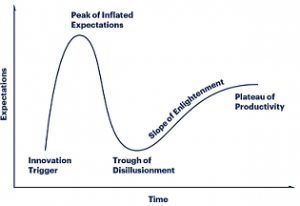[Editor’s Note: Mad Scientist Laboratory is pleased to present our latest edition of “The Queue” – a monthly post listing the most compelling articles, books, podcasts, videos, and/or movies that the U.S. Army’s Mad Scientist Initiative has come across during the previous month. In this anthology, we address how each of these works either informs or challenges our understanding of the Future Operational Environment (OE). We hope that you will add “The Queue” to your essential reading, listening, or watching each month!]
1. “Killer Apps The Real Dangers of an AI Arms Race,” by Paul Scharre, Foreign Affairs, May/June 2019.
 Game changing Artificial Intelligence (AI) technology is up for grabs. Whichever country takes the lead in AI will likely use it to gain advantages over its competitors and will thus revolutionize warfare. Thus, the emerging narrative of an “AI arms race” reflects a misguided view of the risks from AI—and introduces significant new risks as a result. The real danger in AI is not falling behind competitors and then compensating by doubling down on investments; rather, it is the perception of an AI arms race which will prompt everyone to rush to deploy unsafe AI systems. Talk of an arms race encourages adversaries and others to cut corners on safety, despite the associated risks.
Game changing Artificial Intelligence (AI) technology is up for grabs. Whichever country takes the lead in AI will likely use it to gain advantages over its competitors and will thus revolutionize warfare. Thus, the emerging narrative of an “AI arms race” reflects a misguided view of the risks from AI—and introduces significant new risks as a result. The real danger in AI is not falling behind competitors and then compensating by doubling down on investments; rather, it is the perception of an AI arms race which will prompt everyone to rush to deploy unsafe AI systems. Talk of an arms race encourages adversaries and others to cut corners on safety, despite the associated risks.
AI technology is beginning to divide policy makers in Washington, DC, and Silicon Valley entrepreneurs regarding how it can be used by the military. “Employees at Google and Microsoft have objected to their companies’ contracts with the Pentagon, leading Google to discontinue work on a project using AI to analyze video footage.” The implications of an industry / military divide is serious, the consequences of which could stifle progress and collaboration. Chinese technology innovations, which are not open to dissent like they are in the U.S., “will translate more easily into military gains. Even if the United States keeps the lead in AI, it could lose its military advantage.”
“AI technology poses risks not just to those who lose the race but also to those who win it.” Boosting funding for AI safety research is key. Computers, like AI, have massive vulnerabilities. In some instances, computer vulnerabilities have only been discovered after the product has been rushed to market. Digital security cannot be an afterthought for AI, where “widespread, unprotected AI systems is the default setting.” Toning down the ‘race’ and focusing on ensuring AI safety with other countries is a key step. It is important to note “machine-learning systems are only ever as good as their training data.” AI systems go from “supersmart” to “superdumb” in an instant. Adopting safety measures to prevent loss of control are paramount.
2. “The Future Is Here, and It Features Hackers Getting Bombed,” by Elias Groll, Foreign Policy, 6 May 2019.

On Sunday, May 5th, the Israel Defense Forces (IDF) blocked a cyber-attack by Hamas-affiliated cyber operatives and reciprocated with an airstrike in Gaza that ostensibly targeted the building where the cyber attackers were working. The IDF’s Twitter account then tweeted a joke that, “HamasCyberHQ.exe has been removed.” While this is not the first physical response to cyber incursions or attacks (see the U.S. airstrike on Islamic State hacker Junaid Hussain), it is high-profile and may represent a shift in the relationship between warfare in the cyber and physical domains.
Increased hostilities, brinksmanship, and sparring between state actors, violent non-state actors, and super-empowered individuals broaches the question as to where the threshold exists where cyber actions (offensive, defensive, malevolent, incidental, and otherwise) move from the competition phase to conflict. What constitutes an act of war? Is a cyber-attack on “private” social media outlets outside the realm of physical retaliation? Are denial-of-service (DoS) attacks on national financial institutions that cause market crashes or massive fluctuations cause for equivalent cyber-attacks or even armed intervention? These questions loom large as global interconnectivity, market interdependence, and an increasing reliance on digital services (commerce, infrastructure, government functions, etc.) converge so that much of a nation’s paramount foundations exist in the cyber domain.
3. “The Most Hyped Technology of Every Year from 2000 – 2018,” by Nick Routley, The Visual Capitalist, 4 April 2019.

The time is near for Gartner’s annual Hype Cycle visual. Last year’s cycle identified five emerging trends: 1) Democratized AI, 2) Digitalized Eco-Systems, 3) Do-It-Yourself Bio-Hacking, 4) Transparently Immersive Experiences, and 5) Ubiquitous Infrastructure. So how did they do? Like any attempt to forecast the future, the results are a mixed bag. How do we “discern the hype from what is truly commercially viable?”
Nick Routley’s exceptional visuals of past cycles highlights three categories of hyped tech: 1) occasionally a technology lives up to the hype. 2009’s peak tech, Cloud Computing, is transforming entire industries and touches almost every connected device; 2) that same year book readers failed to ever move mainstream — Today, only 19% of U.S. adults own a kindle like device; and 3) some technologies stall in the “Trough of Disillusionment” like 3D printing that is supporting prototyping but failing to transform global supply chains.
These questions of tech maturity and commercial viability are central to the Army’s requirement and capability development processes. The Army will field a Multi-Domain capable force in 2028 and Leaders have to make decisions on tech insertions.
Check out Mad Scientist’s Potential Game Changers (our Hype) — Which one of these will transform warfighting, lag but deliver, or just fail to materialize?
4. “Recode Decode at TED: Space environmentalist Moriba Jah wants to know how much “junk” is in Earth’s orbit,” by Eric Johnson, Vox, 29 April 2019. (TED Talk)
 “In the absence of knowledge, people become very paranoid” — Dr. Moriba Jah, discussing the lack of consistent information about space debris and objects in orbit.
“In the absence of knowledge, people become very paranoid” — Dr. Moriba Jah, discussing the lack of consistent information about space debris and objects in orbit.
Dr. Jah was recently selected as a TED fellow and gave an interview with the podcast Recode Decode in which he discusses his space monitoring system ASTRIAGraph. Dr. Jah stresses the importance of monitoring space debris as damage from minute particles can affect government satellites and communications, banking and commerce, agriculture, weather monitoring and warning systems, and even the internet. The key problem Dr. Jah highlights is that the answer to “what exactly is up there” varies, depending on who you ask — every government and research institution has a different answer based on their information and metrics. What Dr. Jah seeks to do is provide an open-source, universal database for tracking objects in orbit.
In addition to dealing with active assets, Dr. Jah also explains the dangers of the GEO Graveyard — where dead satellites and equipment orbit. The problem is, what is put in the graveyard doesn’t always stay there, leading to the problem of “zombie objects.” These objects pose a great threat because they are no longer being controlled from Earth and are difficult to track, meaning that a satellite that’s been defunct for decades can cause damage to an asset, satellite, or piece of equipment that performs critical functions today. It’s not just active systems that anyone operating in space has to be concerned about, they also have to consider the debris from decades of sending objects into orbit, and leaving them there.
5. “A Constellation of CubeSats,” Innovation Now podcast, posted by WHRO on 9 May 2019.
 As noted by proclaimed Mad Scientists Dr. Moriba Jah and Dr. Diane Howard in their presentation on Space Traffic Management and Situational Awareness during last month’s Mad Scientist Disruption and the Future Operational Environment Conference at the University of Texas in Austin, there are ~500,000 objects orbiting the earth posing potential hazards to our space-based services. We are currently able to only track less than one percent of them — those that are the size of a smart phone / softball or larger. Only about 2,000 of these objects are functioning assets, while the rest are space junk and debris. These objects pose potential collision hazards and provide our adversaries with concealment, masking their potential space threats .
As noted by proclaimed Mad Scientists Dr. Moriba Jah and Dr. Diane Howard in their presentation on Space Traffic Management and Situational Awareness during last month’s Mad Scientist Disruption and the Future Operational Environment Conference at the University of Texas in Austin, there are ~500,000 objects orbiting the earth posing potential hazards to our space-based services. We are currently able to only track less than one percent of them — those that are the size of a smart phone / softball or larger. Only about 2,000 of these objects are functioning assets, while the rest are space junk and debris. These objects pose potential collision hazards and provide our adversaries with concealment, masking their potential space threats .
The world’s first crowd-sourced space traffic monitoring system – ASTRIAGraph – developed by Dr. Jah and the University of Texas, will enable us to more accurately predict and deconflict space traffic by providing users with a common operating picture of space. The effectiveness of this Space Domain Awareness tool may soon be exponentially enhanced through on-going research at the University of Maryland, College Park, where a team is investigating a new method of detecting and tracking sub-centimeter debris “no bigger than a flake of paint” in the near earth environment. Per Principal Investigator Dr. Christine Hartzell, an equatorial constellation of cubesats equipped with Langmuir probes could be used to detect the Soliton Waves associated with these tiny objects and map their locations. NASA’s Innovative Advanced Concepts (NIAC) Program is funding this study, which may provide us with a safer spacecraft environment and, in the words of Martha Reeves and the Vandellas, leave our adversaries “nowhere to hide” in space.
6. “JP Morgan Chase tests neuroscience-based video games to recruit interns,” by Anna Irrera, Reuters.com, 18 March 2019.
 In order to broaden the pool of potential applicants, JP Morgan Chase is using neuroscience-based video games to assess candidates’ social, cognitive, and behavioral features. The software compares the candidates’ attributes to their own successful employees as they feel resumes of personnel new to the workforce have less predictive value than this approach. For the Army, looking to increase recruitment and assign new Soldiers the more suitable MOS, this approach could be appealing. If the Army could identify early on, with greater reliability, what expertise a new recruit has, or who in the current force they most closely resemble, it could make for a more efficient recruiting process, potentially longer retention, higher morale, and a more effective force overall. Could this method be applied beyond recruitment? Will the use of a video game change the demographics of the candidate pool? Are the metrics the Army currently employs for measuring Soldier effectiveness accurate enough for this approach to be meaningful?
In order to broaden the pool of potential applicants, JP Morgan Chase is using neuroscience-based video games to assess candidates’ social, cognitive, and behavioral features. The software compares the candidates’ attributes to their own successful employees as they feel resumes of personnel new to the workforce have less predictive value than this approach. For the Army, looking to increase recruitment and assign new Soldiers the more suitable MOS, this approach could be appealing. If the Army could identify early on, with greater reliability, what expertise a new recruit has, or who in the current force they most closely resemble, it could make for a more efficient recruiting process, potentially longer retention, higher morale, and a more effective force overall. Could this method be applied beyond recruitment? Will the use of a video game change the demographics of the candidate pool? Are the metrics the Army currently employs for measuring Soldier effectiveness accurate enough for this approach to be meaningful?
7. “Tesla battery researcher is ‘excited’ about new battery tech developed by the Army,” by Fred Lambert, Electrek.co, 13 May 2019.
 Hearkening back to the days when DoD innovation paved the way for industry, and technology transitioned out of Government to the private sector, the Army Research Lab has developed a new Lithium Ion battery technology that is catching the attention of one of the most popular automotive companies around – Tesla. The implications from this breakthrough are clear and compelling for the Army: lighter weight, more reliability, and hardened for use in austere environments. Unburdening the Soldier and the associated logistics will enhance warfighter effectiveness and take less of a physical toll on a Soldier. If this technology proves to be operationally effective, this could also mean an accelerated path to electric military vehicles and an advantageous partnership with industry. For the Army, is this the beginning of a reversal of recent history? Will this be the first of a new precedent where the military, once again, begins to drive the Nation’s innovation? Or is this the new norm where the DoD and the private sector share innovation lead?
Hearkening back to the days when DoD innovation paved the way for industry, and technology transitioned out of Government to the private sector, the Army Research Lab has developed a new Lithium Ion battery technology that is catching the attention of one of the most popular automotive companies around – Tesla. The implications from this breakthrough are clear and compelling for the Army: lighter weight, more reliability, and hardened for use in austere environments. Unburdening the Soldier and the associated logistics will enhance warfighter effectiveness and take less of a physical toll on a Soldier. If this technology proves to be operationally effective, this could also mean an accelerated path to electric military vehicles and an advantageous partnership with industry. For the Army, is this the beginning of a reversal of recent history? Will this be the first of a new precedent where the military, once again, begins to drive the Nation’s innovation? Or is this the new norm where the DoD and the private sector share innovation lead?
If you read, watch, or listen to something this month that you think has the potential to inform or challenge our understanding of the Future OE, please forward it (along with a brief description of why its potential ramifications are noteworthy to the greater Mad Scientist Community of Action) to our attention at: usarmy.jble.tradoc.mbx.army-mad-scientist@mail.mil — we may select it for inclusion in our next edition of “The Queue”!



